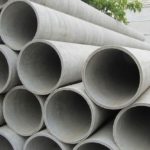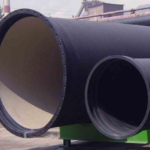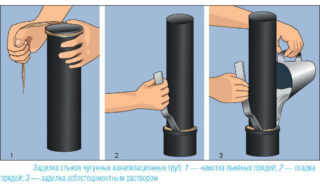Pipes for utilities are chosen depending on the location and purpose of the pipeline, the volume of circulating water or wastewater. The main parameters are diameter, thickness and material. The most in demand are polymer products. For laying the outer (street) part of the collector, a red sewer pipe with a diameter of 110 mm in private households and 200-300 mm in public networks is used.
The use of pipes with a diameter of 300 mm and materials of manufacture
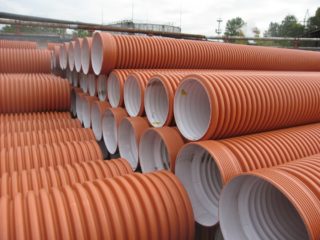
Products with a large cross-section are intended for laying the outer part of engineering networks: public sewage mains, underground storm drains or cable ducts. Such tubes are not used inside buildings.
There are several types of sewer pipes on the market, which are divided according to the material of manufacture. Rating as the popularity of the product grows:
- Reinforced concrete. Such tubes are gradually becoming a thing of the past and are being used less and less. The main prerequisite for this is too much weight, requiring special equipment when laying the highway and the relative fragility of the material. A strong pinpoint impact may cause the pipe to burst. With careful installation, a reinforced concrete collector lasts up to 70 years. But at the same time, its walls have a relative roughness, so the collector silts up over time. Reinforced concrete is resistant to temperature extremes and inert to aggressive impurities in drains, it can withstand pressure from the soil well.
- Cast iron. Strong, durable material. It has a lot of weight, which is not always convenient. To transport and lay the metal collector, you will need to hire special equipment. The service life of cast iron is 50 years or more. Metal is prone to corrosion. Most often, cast iron pipes are used when laying complex highways. In private construction, such products are not used.
- Asbestos cement. A relatively new, updated version of reinforced concrete pipes. In their manufacture, cement solution is mixed with polymers, which act as reinforcement. The result is a strong, durable and lightweight material with perfectly smooth inner walls. Asbestos-cement pipes are capable of withstanding heavy loads, both static and dynamic. Laying can be done in 4 hands.
- Polyethylene. Tubes are good for laying underground utilities. PET has a tendency to linear stretching, is inert to temperature extremes and aggressive media. The inner walls are perfectly smooth, which allows the use of polyethylene products for non-pressure networks. They serve from 50 years, while being easy to install.
- Polyvinyl chloride. For laying the outer parts of the collector, only pipes painted in orange are used. The grays are for indoor use. A reddish tint indicates that the material reacts well to temperature changes and has a high resistance to static, dynamic loads. For greater resistance to soil pressure, PVC tubes are placed in a special corrugation. The rings act as stiffeners here. As a result, corrugated products can withstand pressures up to 120 atm. Red pipes are inert to aggressive media, calmly and without pressure transport large volumes of wastewater due to the smooth inner walls.
In order for tubes with a cross section of 300 mm to calmly withstand the pressure of the soil, their walls are made with a thickness of 16 to 29 mm.When buying, you need to pay attention to the indicator of the inner diameter. Products are produced with or without sockets.
Principles of installation of a pipeline with a large cross-section
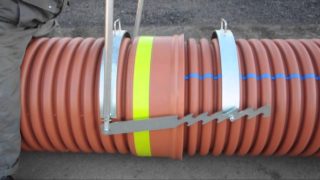
Depending on the material of manufacture, sewer pipes with a cross section of 300 mm are connected in different ways.
Reinforced concrete and cast iron products are joined together in a socket using a special solution. For its preparation, cement, water, glue are combined in a ratio of 2: 1: 1. The mass is well kneaded until smooth. Lay the first tube with a bell to the next. The next section of the collector is driven into it until it stops with the narrow end. The gap between the flare collar and the segment of the next element inserted into it is caulked. To do this, use old rags, tow, scraps of paper. The prepared solution is applied on top and allowed to dry completely.
Asbestos-cement pipes can be connected in different ways. If a double-breasted coupling is used to join two tubes, the stages of work look like this:
- A coupling is put on the junction of the two elements, after having inserted an O-ring into it. In this case, the fitting must be located strictly perpendicular to the axis of the collector.
- Clean the surface of two tubes at the junction from dust and dirt.
- The next element is brought to the previous one and, with the help of a jack, first move the coupling away from you, and then towards yourself. As a result, the fitting, as it were, covers two parts of the pipeline at once.
If the master decides to use a PET sleeve, the joining of two asbestos-cement products takes place in the following sequence:
- Lay two elements in the previously prepared trench.
- In hot water (about 90 degrees), the sleeve is heated, the section of which is still several mm less than the outer diameter of the tubes.
- The elasticized fitting is forced onto the pipes so that both ends rest against the inner stop of the ring.
- The two parts of the future collector are as close to each other as possible.
- The abutting sides of the tubes are cleaned of dirt and dust.
- Mounting sleeves and flanges are put on the ends of the products.
- Two pieces of tubes are pressed as much as possible, and the coupling is pulled together by fixing bolts.
When using a cast iron fitting, it is possible to assemble a split manifold. If necessary, it will be possible to replace one of the sections of the highway.
PVC pipes with a diameter of 300 mm for external sewerage are mounted in a bell. A special rubber seal is used, usually already included in the kit. If it is not there, you will have to specially purchase it. When installing a polyvinyl chloride collector, first insert the ring into the socket of the tube until it stops. The narrow edge of the next element is lightly sanded to improve the adhesion of the sealant to it. A thin layer of silicone is applied to the prepared edge, wait 30-40 seconds and drive the tube into the socket until it stops. The entire network will dry for about a day. After that, the manifold can be checked for leaks and backfilled.
It is better not to ram the soil over the polymer pipeline. Over time, he will shrink himself and all that remains is to pour the earth into place.
Cost of pipes 300 mm
Prices per meter of plastic sewer pipe with a diameter of 300 mm vary depending on the manufacturer and the composition of the polymer. High-quality material costs on average 1000-2000 rubles. Cast iron products are many times more expensive.
For the installation of a private collector, it is better to use corrugated products. They can also be used as wells for laying underground stormwater.

